
50 minute read
How Tech Ticks

IT AMAZES ME; IT IS A
Advertisement
TRUE TEAM EFFORT. OUR UNIVERSITY DECIDED TO INVEST INTELLECTUAL AND FINANCIAL RESOURCES TO DO SOMETHING FOR OUR COMMUNITY. I AM PROUD THAT WE WERE ONE OF ONLY A HANDFUL TO DO THAT."
Carla Finkielstein, scientific director of the Virginia Tech Molecular Diagnostics Laboratory at the Fralin Biomedical Research Institute at VTC
VIRAL RESPONSE For videos, links to the most up-to-date COVID 19 information, and further details about the university’s response to the pandemic, visit vtmag.vt.edu.
TESTING 1, 2, 3
INSTRUCTORS ACROSS CAMPUS employ various types of examinations to assess progress and ensure that each member of their class successfully grasps course content. But with the fall 2020 semester, testing took on a whole new meaning at Virginia Tech.
In preparation for the return of faculty, staff, and students to campus during the pandemic, the university developed a comprehensive testing, tracing, and case management plan as part of its broader effort to mitigate the spread of COVID-19.
In March 2020, with hospitals challenged by shortages of critical resources to provide care for COVID-19 patients and diagnostic labs overwhelmed with patient samples, a campus-wide group of Virginia Tech faculty researchers, postdoctoral fellows, lab technicians, students, and administrators developed a way to provide testing for the region and for the Virginia Tech community.
By April, Virginia Tech biomedical researchers customized their own method to detect the SARS-CoV-2 virus, which causes COVID-19, in samples provided by health providers in coordination with the Virginia Department of Health.
Using a redesigned version of a realtime, quantitative polymerase chain reaction (RT-qPCR) protocol, Virginia Tech made improvements to search for not just a single genetic sequence of the virus, which could compromise the quality of reporting results, but for three unique gene sequences in the virus. In that way, the test was more accurate and functional with custom-designed chemicals and reagents, avoiding many of the supply problems that thwarted early testing in the nation. TW
Current surveillance testing is regular testing of four categories: -high-contact employees
and students. ongoing student Testing
population testing. -student-athlete testing. -prevalence testing.
Prevalence testing is random testing of a population of people who are assumed to be non-symptomatic in order to compare the number of people who have the virus with the total number of people tested.
Dashboard
The COVID-19 online dashboard, which can be found at ready.vt.edu, was launched to share the reports of COVID test results administered by Schiffert Health Center. It is updated Monday through Friday.
It monitors: - availability of oncampus quarantine and isolation space. - positivity rates, the total number of cases, and the number of tests performed. - available hospital capacity.
Process
1. Testing kits are assembled by Virginia Tech’s Molecular
Diagnostics Laboratory team.
2. The kits which contain a collection tube with media and a nasal swab, or for collection of saliva samples, a saliva collection tube, are coded and de-identified before they are transported to the Health Department or Schiffert Health Center for sample collection from patients.
3. The samples are then returned to the Molecular Diagnostics
Lab for analysis.
4. Test results are usually reported back within 24 to 48 hours.
DID YOU KNOW?
Between Aug. 3 and Oct. 21, 2020, Virginia Tech processed 24,843 tests of students and employees. These tests revealed 1,345 positives.
Lab
The Virginia Tech Schiffert Health Center Molecular Diagnostics Laboratory began analyzing COVID-19 test samples on April 20, working through an application for a U.S. Food and Drug Administration-issued Emergency Use Authorization.
The testing lab is located at the Fralin Biomedical Research Institute at VTC.
It can analyze up to 1,000 individual samples per day, and can process up to 1,600 when using an approved sample pooling method.
GLOBAL PERSPECTIVES
I WOULD TELL PEOPLE, DON’T BE IN SUCH A RUSH TO LEAVE
YOUR FAMILY. I GUESS I REALLY DIDN’T REALIZE HOW MUCH TIME I’D SPENT AWAY FROM THEM, AND I FEEL LIKE PEOPLE SHOULD CHERISH THAT TIME TOGETHER.”
Mikun Adewole THE TIME IS 10 P.M. IN KAZAKHSTAN, and Kabyl Oxikbayev’s classes are just starting for the day.
For the next seven hours, the senior civil engineering major will listen to live lectures, participate in meetings, and even catch up with friends in Blacksburg. His days end at 5 a.m.
“My philosophy is that I am up during business hours,” said Oxikbayev, who in May left Blacksburg for his home country in Central Asia, which is in a time zone that is 10 hours ahead of the U.S.
Oxikbayev isn’t the only Hokie who has taken on a completely new schedule this semester. Other students who returned to their home countries are taking courses from different time zones and pulling alI-nighters to remain enrolled as active students. Some, like Mikun Adewole, experienced this reality when the pandemic began last spring.
Hokies around the world are striving to make the best of a challenging year.
MIKUN ADEWOLE: A SEMESTER DISRUPTED
Mikun Adewole was staying with family members in Maryland when he learned the university was extending spring break as a result of the COVID-19 pandemic. Fearing travel to Nigeria, where his immediate family lives, would soon become difficult, his mother quickly arranged for him to fly home to Lagos, the country’s largest city.
“The day after I got back [to Nigeria], the airport closed, and it’s still closed,” said the junior chemical engineering student.
In the months that followed, Adewole found himself navigating his online courses, as well as adjusting to a five-hour time difference.
Adewole, who did secure safe transport back to the U.S. this summer, says it is a relief to be back in Blacksburg, but he also is grateful for the time he had in Nigeria.
“I would tell people, don’t be in such a rush to leave your family,” he said. “I guess I really didn’t realize how much time I’d spent away from them, and I feel like people should cherish that time together.”


Danah Alnajidi
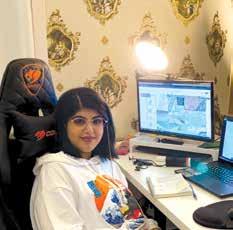
KABYL OXIKBAYEV: LEADING ACROSS THE WORLD
Not only is Kabyl Oxikbayev juggling his senior year of classes, he also is leading an international student organization virtually. In June, Oxikbayev became president of the Council of International Student Organizations, a group that represents and advocates for international students at Virginia Tech.
Generally, Oxikbayev meets with the council’s 10-member board every two weeks, and many join virtually from other countries, including China, India, and the U.S.
“Even though it’s been a challenge, it does give me a certain level of experience and valuable insight that I feel like I would not have gotten had everything been the same or normal,” said Oxikbayev.
Oxikbayev is on a completely opposite schedule than his parents. He goes to bed when they wake up in the mornings. They eat dinner together before his classes begin.
“Staying up late at night to not only do assignments but to be mentally and physically present for a lecture, it’s a bit of a struggle,” he said. “But I’m just thinking of it in a way that in 10 years I’ll be looking back, and, hopefully, I’ll be laughing about it.”
Najd Alnajidi
DANAH AND NAJD ALNAJIDI: CREATIVITY FLOURISHES AT NIGHT
Sisters Danah and Najd Alnajidi didn’t want to leave Northern Virginia to return home to Saudi Arabia last spring. But when the coronavirus pandemic began, their family was worried for their safety.
The sisters are graduate students studying architecture at the Washington-Alexandria Architecture Center, a Virginia Tech campus in Alexandria, Virginia.
“It was the most stressful thing,” said Najd Alnajidi, explaining that they had to pack up their Alexandria apartment, move their belongings to storage, and leave their two cats with a friend.
Once they arrived in Saudi Arabia, they had to quarantine for 14 days in a city that was on lockdown. No one could leave their houses except to go to the grocery store.
All along, the sisters knew that it would be impossible for them to return to the U.S. for their fall semester, because no air travel was allowed. They were determined not to fall behind in their classes.
“I would have to take a whole semester off,” said Najd, who is in her second year of the architecture program. The sisters retrofitted a study and living area in their home and convinced their family to upgrade the house’s WiFi so that they could better access their classes online.
Their classes begin at 8:30 p.m. and end by 5 a.m. They sleep during the day, waking up in time for dinner and other activities with their family.
Danah Alnajidi, who is in her first year of the architecture program, said she’s looking forward to having a daytime class schedule once they are able to return to the U.S.
“I don’t mind being on Zoom classes, but I would rather be in Alexandria,” said Danah.
Another challenge this semester for Najd is not being able to take some of the hands-on classes. She said she also misses being able to print large architectural drawings.
Luckily, both sisters have enjoyed staying up late in the past and that has worked in their favor with their new class schedule.
“We get so invested in ideas that we don’t want to go to sleep,” said Najd. “We know that once we sleep, the next day that idea
won’t be there.” TW/JKB
ANY HOKIE WHO HAS SPENT TIME ON the Blacksburg campus has experienced its wildlife in some way: a songbird’s dawn reveille, a squirrel dashing across the Drillfield, Otter Sandman fishing in the Duck Pond, or even the occasional appearance of a black bear.
Animal species have become more prevalent on and near campus, both because they’re adapting to an increasingly urbanized landscape and because of efforts to restore places like Stroubles Creek downstream from the Duck Pond and Plantation Road. Virginia regulators found that stretch of Stroubles to be impaired by pollution in 2002, prompting student and faculty efforts through the American Fisheries Society to restore a wildlife-friendly riparian corridor around the creek by tree-planting and fencing out livestock.
“The stretch had been grazed by sheep down to the waters edge,” said Dean Staffuer, professor in the College of Natural Resources and Environment and associate department head for undergraduate
ON THE WILD SIDE

affairs. “Now it’s a nice riparian strip— the result of student actions on campus.”
Kevin Hamed, assistant professor in the Department of Fish and Wildlife Conservation, has conducted wildlife surveys along the creek, as well as recording online classes at the site after the pandemic forced faculty to shift to remote instruction during the spring 2020 semester.
Stroubles Creek is accessible by an extension from the Huckleberry Trail and has become a hotspot for birders and wildlife watchers. MA

Wildlife Hotspots
Duck Pond
Pond between Southgate Drive and Virginia-Maryland College of Veterinary Medicine
Forested area between the Grove and Duck Pond
Center Woods (forested area on southwestern side of Huckleberry Trail between campus and Prices Fork exits)
Green area around War Memorial Gymnasium
ANIMAL ATTRACTION For more photos and information about campus wildlife, visit vtmag.vt.edu.

182
Number of bird species observed at the Duck Pond.
Fish
mountain red-bellied dace margined madtom river chub creek chub white sucker sculpin bluegill largemouth bass
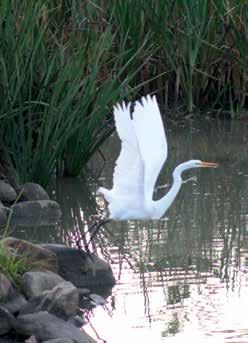
Reptiles
turtle (various) garter snake water snake
Amphibians
American toad long-tailed salamander two-lined salamander red-backed salamander bullfrog spring peeper
Mammals
mink river otter muskrat short-tailed shrew (the only venomous mammal) cottontail rabbit white-footed mouse deer mouse deer
Birds
red-winged blackbird song sparrow white eyed vireo northern oriole blue jay gold finch robin woodpecker (various) kingfisher great blue heron green heron great egret coopers hawk red-tailed hawk barn owl
123
Number of bird species observed along Stroubles Creek.

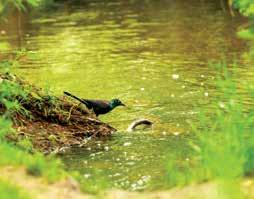

WHAT DID YOU SAY?

TIPS FOR COMMUNICATING WITH MASKS ON
Speak louder, shout if you have to—that’s how Kristin Rice has been communicating with others, particularly while outdoors with half of her face covered by a mask. “In a crowded area, you are shouting to be heard, to be as loud as possible while social distancing,” said the Virginia Tech freshman, who plays the alto saxophone with the Marching Virginians. “It’s a struggle.” Along with other band members, Rice cut a hole in her mask in order to play her instrument. Meanwhile, Michael Dashiell, a Virginia Tech sophomore, has figured out a trick to prevent his glasses from fogging up while he’s wearing a face mask. He pushes his glasses further down on his nose, so that they rest on top of his mask. Face coverings now are a part of our daily apparel. Just like people put on clothes every day before venturing out in public, masks are a part of the recommended dress code to slow the spread of COVID-19. Throughout the commonwealth and across Virginia Tech’s campuses, face coverings are required indoors and outdoors when physical distancing isn’t possible. But with only the eyes and forehead visible behind a face covering, communication can be tricky. “It [communicating] requires a lot more consciousness of our bodies and our eyes when we are out in public wearing a mask,” said Patty Raun, a professor in the School of Performing Arts at Virginia Tech and director of the Center for Communicat-
Patty Raun, a professor in the School of Performing Arts
ing Science. “We need to overcompensate for the most expressive part of the face.”
For example, on a recent trip to a local restaurant to pick up a to-go food order, Raun said she found herself exaggerating her signals with the staff. She spoke slowly and pointed to items on the menu, all while her eyebrows were rising up and down.
That’s because her mask covered her nose and mouth, forcing her to figure out how to give her order without using her typical facial expressions.
“We have to slow down our speech. We have to articulate more clearly and use more pitch variety,” said Raun. “I have to remember that they can’t see that really effective part of my face. I have to let myself exaggerate.”

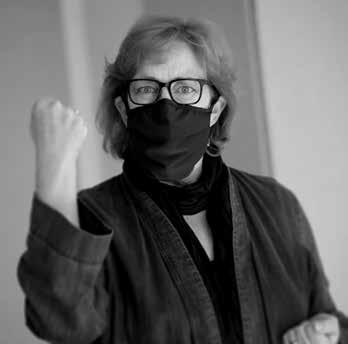
Patty Raun
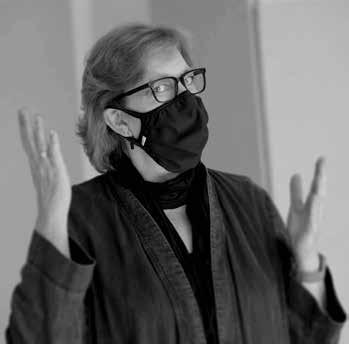
Aside from speaking, nonverbal body language is just as important in communicating with others, and movement of the torso is key, said Greg Justice, an associate professor in the School of Performing Arts at Virginia Tech. That includes everything from posture to orientation of the body.
After all, 50 percent of effective communication happens through body language and nonverbal methods, he said. Meanwhile, 40 percent of communication is vocal, and only about 10 percent happens with words.

“We can lie like crazy with our face, but we can’t lie with our torso,” Justice said. Another challenge is showing genuine friendliness behind a mask. Raun said she wants people in public to know that she is smiling at them, even though they can’t see her mouth. Looking at someone’s eyes and their forehead can give clues as to whether they are smiling or frowning, she said. To show anger, the eyes typically are lowered or pinched together. But the skin around the eyes moves when someone is genuinely smiling. Look for crow’s feet at the corner of people’s eyes or squinting to see a smile, she said. “Joy is very clear in the eyes,” said Raun, explaining that she uses eye and mind exercises for students in her acting classes. “You can see so much from that little two inches.”



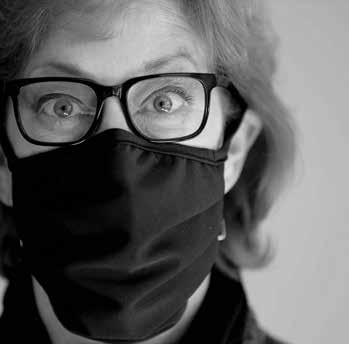

She said she particularly likes the masks that have a smile printed on them. Making eye contact is especially critical while wearing a face covering, as well as changing the tone and pitch of one’s voice to convey a message, said Robin Panneton, an associate professor of psychology at Virginia Tech. Her research focuses on infants’ and toddlers’ attention to and perceptions of language. “We might need to be more mindful of how important the body is in how we convey our enthusiasm and our skepticism,” Panneton said. But masks aren’t the only obstacle affecting our current communications with co-workers, family, and friends. There’s another challenge created by the pandemic—communicating behind screens. This applies to Zoom and other web platforms that people now use regularly for office meetings, group events, and even social gatherings in order to maintain physical distance. For onscreen communication, people should remember that the camera is their friend, said Justice. For instance, when talking with others online, we often want to look at the people on the screen, rather than directly at the camera. But Justice advises people to look at the camera,which is typically located at the top of the display; otherwise, they appear to be looking down at the others on the screen. “The speaker must behave like that glass is actually the person(s) they are talking to,” said Justice, who suggests attaching a sticky note just above the camera that states “Look here” in order to train the eyes.
To be sure, communicating with others well right now takes more effort, intense attention, and some creativity, Raun said, calling it a “paradox of the times.”
“When we are on Zoom or video communication, our nonverbals are limited to head and shoulders,” she said. “We’ve got one kind of limitation through part of our day, then we go out in public and we have the opposite problem.”
Even more so in public, “we need to be very intentional about remembering that there is a human being behind that mask, that there’s a person with a lot of life things going on,” Raun said. JKB
HOW TO COMMUNICATE BEST BEHIND A FACE MASK:

• ENUNCIATE YOUR WORDS.
• SPEAK LOUDER.
• USE HAND SIGNALS.
• EXAGGERATE.
• BE AWARE OF BODY LANGUAGE.
• MAKE EYE CONTACT.
• STUDY THE EYES.
• CHANGE THE PITCH OF YOUR VOICE.
SCIENTIFIC RELEVANCE
BY MATT CHITTUM
WITH THE COVID-19 PANDEMIC BEARING DOWN, CRUCIAL CAPACITY TO TEST FOR THE VIRUS WAS IN SHORT SUPPLY.
RESEARCH SCIENTISTS AT THE FRALIN BIOMEDICAL RESEARCH INSTITUTE AT VTC AND COLLEAGUES ON THE BLACKSBURG VIRGINIA TECH CAMPUS PIVOTED FROM THEIR USUAL SCIENCE TO EMBRACE AN EMERGENT NEW ROLE.
WORKING THROUGH THE OFFICE OF THE VICE PRESIDENT FOR HEALTH SCIENCES AND TECHNOLOGY, VIRGINIA TECH EARNED RAPID APPROVAL FROM STATE AND FEDERAL GOVERNMENTS TO ANALYZE COVID-19 TESTING SAMPLES AND, IN A MATTER OF WEEKS, LAUNCHED LABORATORIES THAT DRAMATICALLY EXPANDED THIS IMPORTANT RESOURCE IN SOUTHWEST VIRGINIA. THE WAIT TIME FOR VIRGINIA DEPARTMENT OF HEALTH TEST RESULTS IN THE REGION PLUMMETED FROM A WEEK TO AS LITTLE AS A DAY OR TWO.
“THERE IS NOT ANOTHER PLACE IN SOUTHWEST VIRGINIA THAT HAS THE TECHNOLOGICAL SOPHISTICATION, INSTRUMENTATION, AND SCIENTIFIC EXPERTISE TO RUN THESE TESTS. I DON’T KNOW WHERE ELSE IT WOULD HAVE HAPPENED,” SAID MICHAEL FRIEDLANDER, EXECUTIVE DIRECTOR OF THE FRALIN BIOMEDICAL RESEARCH INSTITUTE AND VIRGINIA TECH’S VICE PRESIDENT FOR HEALTH SCIENCES AND TECHNOLOGY.
TEN YEARS AGO, IT COULDN’T HAVE HAPPENED.
The ability to respond rapidly to a national and community crisis reflects, in part, the university’s decision in 2008, in partnership with Carilion Clinic, to add to its biomedical research infrastructure, embodied over the past decade by the Fralin Biomedical Research Institute.
The institute launched in 2010 with its first faculty member and executive director—Friedlander— and $2 million in extramural research funding from the National Institutes of Health. Today, 33 research team leaders with the support of more than 300 students and staff conduct research with $135 million in active grant awards.
Over the summer, the first of what will eventually be an additional 20 to 25 teams of researchers moved into a new 139,000-square-foot building on the Virginia Tech Carilion Health Sciences and Technology campus in Roanoke, more than doubling the institute’s space and adding what will be another 300 to 400 research faculty, staff, and students.
They’ll investigate new frontiers in biomaterials/body-device interfaces, brain health and disorders, cancer therapeutics, cardiovascular science, obesity and metabolism, and immunity and infectious diseases, including the novel coronavirus.
Investigators will use a highly secure Biosafety Level 3 lab to gauge the effects of COVID-19 on multiple bodily processes, including cardiovascular function. The Virginia-Maryland College of Veterinary Medicine’s Animal Cancer Care and Research Center and the College of Science’s Center for Biostatistics and Health Data Science are also located in the new research institute addition and will contribute to the overall interdisciplinary research enterprise.
Given the achievements of the first decade, the next may be even more dramatic.
THERE IS NOT ANOTHER PLACE IN “ SOUTHWEST VIRGINIA THAT HAS THE TECHNOLOGICAL SOPHISTICATION, INSTRUMENTATION, AND SCIENTIFIC EXPERTISE TO RUN THESE TESTS. I DON’T KNOW WHERE ELSE IT WOULD HAVE HAPPENED. “ MICHAEL FRIEDLANDER, EXECUTIVE DIRECTOR OF THE FRALIN BIOMEDICAL RESEARCH INSTITUTE AND VIRGINIA TECH’S VICE PRESIDENT FOR HEALTH SCIENCES AND TECHNOLOGY

HIGH RESOLUTION: CANCER RESEARCHER JENNY MUNSON (RIGHT) STANDS BESIDE A BRAND NEW MICRO POSITRON EMISSION TOPOGRAPHY (PET) SYSTEM, WHICH IS USED TO VISUALIZE TUMORS WITH HIGH PRECISION AND RESOLUTION.
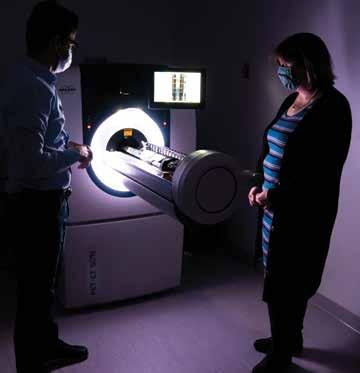
SETTING STANDARDS FOR WORLDWIDE SCIENCE The Fralin Biomedical Research Institute’s job is to create new knowledge. Its scientists have tallied over 700 publications, accrued 35 patents, and are behind numerous important discoveries. In a neurosurgical suite at Wake Forest University Medical Center, surgeons implanted tiny electronic leads into the brain of a Parkinson’s patient, who was awake during the procedure, to implant a deep brain stimulator. Led by Read Montague, the Virginia Tech Carilion Vernon Mountcastle Research Professor, a group of scientists adapted equipment to be inserted surgically into willing patients’ brains and developed a high-speed scanning procedure to identify serotonin fluctuations while the waking patients played a riskand-reward game. The researchers were the first in the world to take such measurements directly in humans, and they documented the first clear evidence that serotonin helps people contend emotionally when events don’t go as they expect. Research at the Fralin Biomedical Research Institute is supported mostly through federal grants, 90 percent of which come from the National Institutes of Health. Industry partners also support the institute, inspired in part by the institute’s modern and innovative approach to translational research, innovation, and entrepreneurship. For example, state-of-the-art imaging equipment manufacturer Bruker selected the institute to partner in using its newest technology that allows for unprecedented high-resolution visualization of structures and biological processes inside the living brain and heart. Also, pharmaceutical company Indivior chose the institute to collaborate on a large-scale follow-up study aimed at developing long-term treatment management of people trying to recover from opioid addiction. And the institute’s full potential is still being realized. “There’s not a full understanding yet of just how impactful the Fralin Biomedical Research Institute can be,” said Heywood Fralin, who with his wife, Cynthia, and the trustees of the Horace G. Fralin Charitable Trust, donated $50 million to the institute in 2018. “There’s nothing that’s going to help the community and the citizens more than this.” The institute is more than fulfilling its promise of scientific relevance and economic power, and it’s poised to reach beyond the region and the state. Children’s National Hospital in Washington, D.C., sought out the institute as a key founding partner for its new innovation campus, where the institute will begin expanding Virginia Tech’s research operations in pediatric brain cancer treatments next summer. Sharon Landesman Ramey and her husband, Craig Ramey, both research professors and distinguished research scholars, were among the first scientists to join the institute. They were on the brink of retiring when they answered Friedlander’s call. The institute’s initial focus on the brain and nervous system rapidly and organically broadened into study of the heart, cancer, neuromotor disabilities, addiction, and other areas. With a relatively modest initial investment compared to larger institutes, Fralin Biomedical Research Institute has overachieved. “We’re just a bunch of hard-charging people who love our work,” Landesman Ramey said. “That’s who we are in the research world. In less than a decade, we made it to the national and international scenes.” “We’re really setting standards for worldwide science,” Friedlander said.
The power of the institute is its people—from pioneering faculty research team leaders to dedicated staff and talented students, he stressed. Scientists at the Fralin Biomedical Research Institute are leaders in using new ways to study a human’s brain during tasks to learn more about the neural activity that underpins actions and decisions, including after brain injuries and when such disorders as major depression or neurodegeneration occur. Investigators are changing views of damage to the heart from heart attack, arrhythmia, and viral infection and developing new insights and approaches for heart-healing. The institute is home to a world-leading program for rehabilitation of the brains of children who had strokes as infants. The institute’s Neuromotor Research Clinic develops new approaches to pediatric rehabilitation for children affected by stroke, cerebral palsy, and brain injury and shares them with other clinicians. “It’s a bit intimidating to think that people come halfway across the world for us to help them here in Roanoke,” said Stephanie DeLuca, director of the clinic. “But it is truly one of the biggest honors of my career that people put their trust and the trust for their children’s development in us and let us be a part of that.” “The science at Fralin Biomedical Research Institute has become an area of celebration and pride and recognition for the university,” Friedlander said. “But it’s also a magnet that draws in other academics—faculty, students, and staff—to participate in collaborative research.” In 2019, institute investigators formed the new campus-wide Virginia Tech Cancer Research Alliance with colleagues in Blacksburg, a cohort of more than 25 research teams seeking new ways to prevent, quickly diagnose, and treat brain, breast, colon, lung, liver, and bone cancers in humans and animals. The institute, along with the Virginia Tech Carilion School of Medicine, was born of a partnership between Virginia Tech and Carilion Clinic, when the university sought to increase its research capacity and the health care system desired an academic association that would help attract more world-class physicians to the region, enhance its level of care, and train future physicians to serve citizens of the commonwealth. Its most dramatic impact in Roanoke has been primarily economic. “In 10 years, the community narrative in Roanoke has changed from an old railroad town to an active outdoor community with a strong innovation space,” said Beth Doughty, executive director of the Roanoke Regional Economic Development Partnership. The institute anchors the city’s Innovation Corridor, an economic development initiative where start-up businesses that spin out of institute research take root and grow the local economy. Investigators at the institute have already developed five new startups, three of which are currently carrying forward innovative ways to diagnose and prevent alcohol addiction, treat aggressive forms of brain and breast cancer, and prevent cardiac injury after a heart attack. “It really is kind of a paradigm shift,” said Roanoke City Manager Bob Cowell. “The Fralin Biomedical Research Institute, right alongside Carilion Clinic, really is setting the new foundation for this community’s economic future.” The institute is only gaining momentum and building critical mass, Doughty said. “The opening of the new building is perhaps as significant as the original creation of the research institute.” “The Fralin Biomedical Research Institute is far more powerful than the railroad would ever be,” Fralin said. “This has far more potential. It ought to be one of the priorities of major philanthropists in the area.”
HANDLE WITH CARE: A LABORATORY TECHNICIAN PERFORMS COVID-19 SAMPLE ANALYSIS IN THE VIRGINIA TECH MOLECULAR DIAGNOSTICS LABORATORY, LOCATED AT THE FRALIN BIOMEDICAL RESEARCH INSTITUTE.

“The Fralin Biomedical Research Institute at VTC has been transformational for the region, the university, and our communities,” said Virginia Tech President Tim Sands. “In addition to the significant economic impact and groundbreaking research, the research institute is addressing key societal issues, such as childhood development, addiction, and community health. The rapid transition to COVID-19 testing demonstrates the university’s capacity to address issues of immediate concern.” “Ten years ago, the partnership between Carilion Clinic and Virginia Tech offered a lot of promise,” said Nancy Howell Agee, president and CEO of Carilion Clinic. “The hard work and commitment of many have left an indelible mark on the region and the scientific and health care communities. The original promise of a decade ago has turned into concrete outcomes that go far beyond economics and bricks and mortar. The institute’s success has exceeded what I could have imagined 10 years ago, and I can’t wait to see what the future will bring.” In 2021, the Fralin Biomedical Research Institute will expand beyond Virginia, into Washington, D.C., when it opens a 12,000-square-foot research facility on the Children’s National Research & Innovation Campus on the site of the former Walter Reed Army Hospital. Leaders at Children’s National Hospital knew Friedlander, the institute, and Virginia Tech’s reputation, and sought the university out as a founding partner for their new project, in part because of shared interest in brain tumor research. Children’s National is a top 10 children’s hospital in the U.S., as ranked by U.S. News & World Report. Its neonatal program is ranked first in the country and its neurology and neurosurgery services ranked third.
CHILDREN'S NATIONAL
RESEARCH & INNOVATION BUILDING (PHASE TWO)
CHILDREN'S NATIONAL
RESEARCH & INNOVATION BUILDING (PHASE ONE: OPENING DEC. 2020
FUTURE HOME OF THE VIRGINIA TECH RESEARCH LABORATORIES

“It really felt like a dream team,” said Kurt Newman, president and CEO of Children’s National Hospital. “For a hospital like ours, there’s nothing like having a first-class research university as a partner. You never quite know where the breakthrough is going to come from or where the smart graduate student, really enthusiastic undergrad, or medical student is going to have the big idea. Having access to that pipeline of intellectual talent, it’s just priceless.” The Fralin Biomedical Research Institute will join a campus already home to JLABS @ Washington, D.C., a collaboration between Children’s National and Johnson & Johnson LLC. “How can you miss with a world-class children’s hospital, a world-class university, and a location in Washington, D.C., with access to the National Institutes of Health, the Food and Drug Administration, and all of the other government research pieces?” Newman asked. “We may even be thinking too small.” “The partnership with Children’s National is another great nexus for us,” Friedlander said, explaining the institute is readying itself with the right people, rich facilities, and strong partnerships to accelerate into the next decade.
WORLD-CLASS RESEARCH In a decade, the Fralin Biomedical Research Institute has expanded from a single researcher with a few million dollars in grant funding to 33 research teams performing groundbreaking research across a wide range of areas. For a full list of the research institute's primary faculty members, please visit fbri.vtc.vt.edu. Here are some highlights of recent research and discoveries by primary investigators and their teams at the institute:
WARREN BICKEL’S team identified brain processes as therapeutic targets for changing a person’s behavior from seeking unhealthy, short-term gratification to more-deliberate planning for the future. This work gives hope to those addicted to opiates, alcohol, tobacco, and smoking. Bickel’s team is extending this approach to other health behaviors, including those that lead to diabetes and obesity.
ROBERT GOURDIE’S interest in heart development and repair led him to discover new molecular therapies and delivery approaches to aid and accelerate wound healing and tissue repair in scarring, diabetic ulcers, and heart repair after a heart attack. He’s moved his work from bench science to starting multiple companies that translate his discoveries to the clinic to heal patients.
SHARON SWANGER is fascinated with how receptors located on individual nerve cells in the brain contribute to the behavior of large-scale circuits formed to produce perception, integration of information, and behavior. Her work focuses on how changes in these molecules can cause circuits to undergo abnormal patterns of activity, leading to such disorders as epilepsy. JAMES SMYTH, initially trained in molecular virology, now uses those tools to study connections between heart muscle cells and how heart disease affects them. He is also taking on the problem of how viral infections, such as COVID-19, attack the heart and blood vessels.
MICHAEL FOX has tracked the developing brain’s guidepost signals for more than a decade. Recently, he and his team made major discoveries illuminating molecular cues that help create functional circuits in the fetal brain. Fox’s work shines new light on the assembly of these connections, and also on how disruption of these processes may be implicated in neuropsychiatric and developmental disorders.
STEPHANIE ROBEL seeks to understand how brain injuries can lead to seizures. Her recent work has shown the first direct cellular evidence for how the glial cells in the brain create hyperexcitable networks that can trigger seizures subsequent to a traumatic brain injury.
SAMY LAMOUILLE is developing new therapeutics to treat brain, breast, colon, and other cancers. His work is aimed at the cells that rekindle abnormal cell growth and proliferation after tumors are removed. Lamouille’s research is the basis of a new company that has received support from the National Institutes of Health through the small business technology transfer program.
WORK THE FUTURE OF
HOW VIRGINIA TECH IS PREPARING THE LEADERS OF TOMORROW, TODAY WRITTEN BY MASON ADAMS | ART BY ANDY POTTS
VIRGINIA TECH’S SERVICE MISSION AND TECHNICAL EXPERTISE HAVE EVER PLACED IT ON THE FUTURE’S LEADING EDGE. HOKIES HAVE PLAYED KEY ROLES IN SHAPING THE WORLD AND THE WAY THAT WE WORK FOR NEARLY 150 YEARS. AND THEY WILL CONTINUE TO DO SO IN THE FUTURE.
THE UNIVERSITY’S 1872 CREATION ARRIVED ON THE TAIL END OF THE INDUSTRIAL REVOLUTION. VIRGINIA TECH’S FORMATIVE FIRST DECADES PLAYED OUT AMID MASSIVE SOCIETAL CHANGES THAT COMPLETELY DISRUPTED HOW PEOPLE CONSIDERED WORK. THE PROGRESSIVE MOVEMENT OF THE EARLY 1900S SHAPED AMERICA’S CONCEPTION OF JOBS AND GAVE WORKERS IMPORTANT NEW RIGHTS, EVEN WHILE TECHNOLOGICAL ADVANCES LED TO RAPID MECHANIZATION BY INDUSTRY. VIRGINIA TECH KEPT PACE, CONTRIBUTING TO LEAPS FORWARD IN AGRICULTURE, ENGINEERING, AEROSPACE, COMPUTER SCIENCE, AND MANY OTHER FIELDS.
NOW, IN 2020, THE CORONAVIRUS PANDEMIC HAS ACCELERATED THE DEVELOPMENT OF TELEWORK AND WORKPLACE SAFETY PRACTICES. AND VIRGINIA TECH IS POSITIONED AT THE RIGHT PLACE AND RIGHT TIME WITH THE RIGHT VISION TO PLAY A CRITICAL ROLE IN ADVANCING THE FUTURE OF WORK WHILE ALSO MAKING IT MORE JUST, INCLUSIVE, AND ACCESSIBLE FOR WORKERS THROUGHOUT THE WORLD.
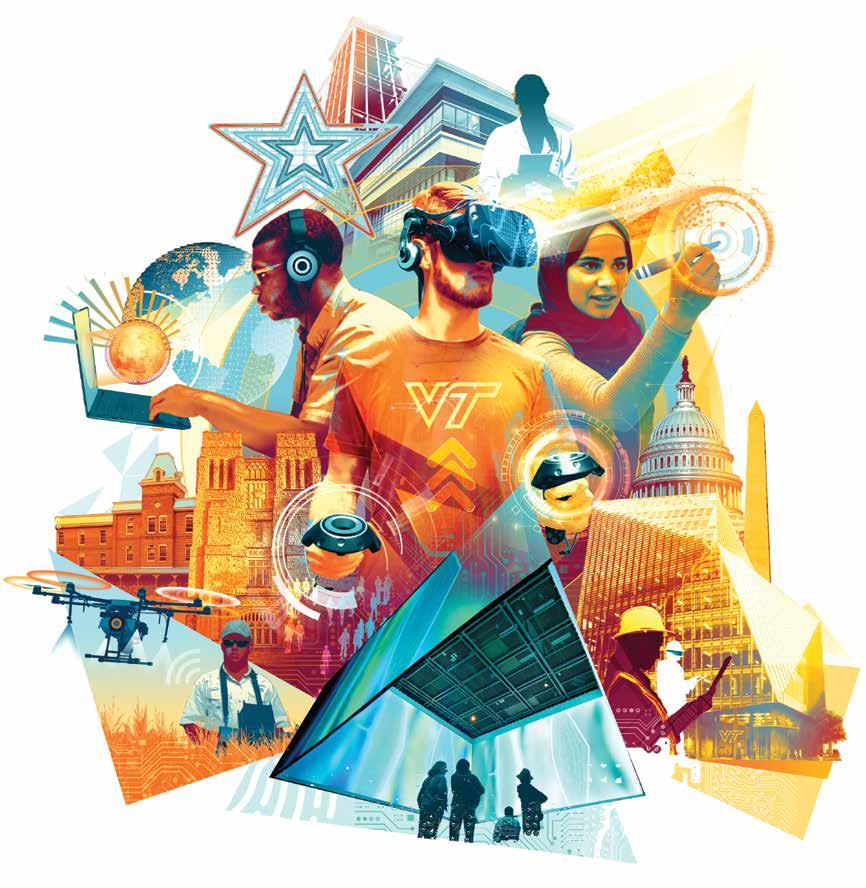
THE AGE OF AUTOMATION Founded in 1872 on the cusp of the Industrial Revolution, the university’s land-grant mission and technical expertise have kept it squarely placed at the forefront of science and technology—from robotics and automated farming to brain science and space flight.
Virginia Tech President Tim Sands’ Beyond Boundaries vision was five years old when COVID-19 rocked the world. In retrospect, that half-decade turned out to be an essential period of preparation that uniquely positioned the university for a global leadership role just when the world needs it most. Virginia Tech has always endeavored to serve, and now it is responding—not just to the crisis of the moment, but to the lasting changes the pandemic will leave in its wake.
“Our strategies, preparation, and hard work make a difference and create real-time results for the commonwealth and the world,” Sands said. “We face the same imperative that energized our predecessors throughout the university’s history—the imperative to grow, evolve, and make the world a better place for everyone. Today, more than ever, Virginia Tech finds itself engaged and ready to honor our motto Ut Prosim (That I May Serve), with momentum, energy, and opportunity on our side.”
The surge in automation that transformed the mass production of goods during the late 1800s and early 1900s only accelerated in the 21st century, disrupting and transforming almost every business sector around the world. The distillation of computing power transformed technology that once occupied entire buildings into smartphones that fit into pockets, and has profoundly changed not only how we work, but how we think. Such innovations affect businesses and members of the workforce across national boundaries, social classes, political alignments, and industries. A 2019 report by McKinsey Global Institute, “The future of work in America,” found that trends are accelerating inequalities, not just between workers but between geographic areas.
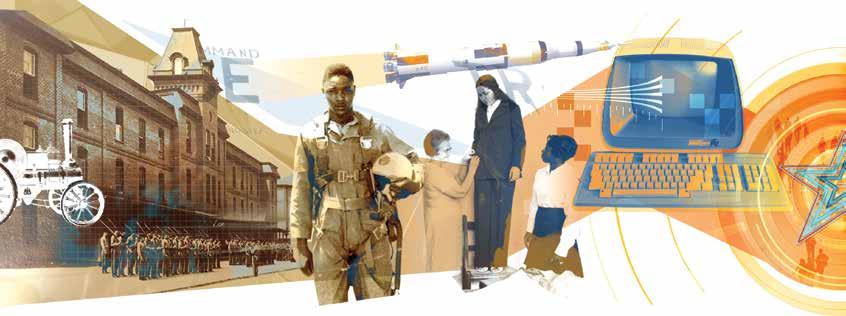
“Without bold, well-targeted interventions, automation could further concentrate growth and opportunity,” the report concludes. “But these trends are not set in stone. It is possible to turn this period of technological change into an occasion to create more rewarding jobs and build better learning systems and career pathways.”
SHAPING THE FUTURE
Virginia Tech’s motto, Ut Prosim (That I May Serve), demands that the university meet this moment, and indeed, it is growing to play a bolder role in the world, expanding programs that will support and direct the progression toward the future.
The university is building relationships with an array of public and private partners to wrestle complex problems, develop innovative solutions, and benefit people everywhere.
In Roanoke, the Fralin Biomedical Research Institute at VTC and Virginia Tech Carilion School of Medicine train leaders for the health care industry—a rapidly growing arena that McKinsey projects will continue to expand well into the future.
In the greater Washington, D.C., metro area, Virginia Tech is building on its existing facilities with the development of the Innovation Campus in Alexandria. Through this new initative, the university will prepare tens of thousands of graduates for roles in computer science, engineering, and other fields whose needs are outstripping the currently available workforce.
But Virginia Tech isn’t just training workers; it’s developing tomorrow’s leaders. In Arlington, the university holds a leadership role in the Commonwealth Cyber Initiative, a partnership that brings together colleges and universities across Virginia. The initiative serves as a catalyst to advance technologies at the intersection of security, autonomy, and data—foundational elements that are necessary glue for the systems that are driving the future of work. In the mid-1960s, Intel co-founder Gordon Moore noticed how rapidly computer science was developing. He posited what became known as Moore’s Law: that the number of components on a circuit would double every year or two. The prediction largely has held up: computing power has rapidly increased while its size has simultaneously decreased. That evolution, which put powerful smartphones into the pockets of 81 percent of Americans, revolutionized how we integrate computers into our daily lives. As a society, we’re still sorting out exactly what this means for how we live.

AN UNEXPECTED SHIFT “Big technological advances don’t initially improve productivity dramatically—firms operate the same way, using new technology,” said Melinda Miller, assistant professor in the Department of Economics. “It’s only once production can be reimagined that the great productivity improvements occur. A classic example is factories, which were initially vertically oriented to take advantage of a single power source, like water or steam, but then became horizontal with the advent of electricity, resulting in the typical assembly line set-up we’re familiar with today.” The pandemic of 2020 unexpectedly introduced a steeper tilt toward remote work and new ways of delivering services, accelerating shifts that were already underway. “While technological transformations and their effects on the future of work are inevitable, it looks like COVID-19 has already expedited the transition,” said Navid Ghaffarzadegan, associate professor in the Grado Department of Industrial and Systems Engineering. “Many workplaces have changed substantially, limiting their physical capacities and letting people work remotely. We are moving from ‘push’ environments, where technologies were mainly advocated by technology developers, to ‘pull’ environments, where technology is demand-driven.” The pandemic’s tilt to telework has made for a more fluid boundary between work and home life for many people, complicating efforts to find a satisfying balance. Charles Calderwood, assistant professor in the Department of Psychology, said that dynamic may persist beyond the pandemic, because organizations are realizing a cost savings from reduced office space, and individuals prefer to curtail time spent commuting. However, many employees in direct customer service settings, such as hospitals or restaurants, have not seen significant changes in their workplaces, even as they face a greater risk of exposure to the virus. “These potentially diverging paths for employees working in different types of jobs have a strong potential to magnify disparities and inequities in work-life balance, which already tend to favor higher-salary and higher-status workers,” Calderwood said. “We also need to be sharply concerned about occupational health disparities that may set in or be magnified for employees who are at greater risk for serious illness from COVID-19. Many employees are struggling to balance working at home while their children are learning virtually, often with little guidance or support from organizations in how to balance these demands.”
ABIOLA AKANMU
ASSISTANT PROFESSOR OF PRACTICE IN THE MYERS-LAWSON SCHOOL OF CONSTRUCTION BUILDING A BETTER WORKPLACE Many Virginia Tech researchers are developing new technologies for fields where on-demand knowledge is vital for efficiency and safety. Abiola Akanmu and Tanyel Bulbul both work with digital modeling in the Myers-Lawson School of Construction, though in different ways. Construction sites increasingly use sensors that can track the location of supplies and equipment, monitor the flow of people and materials, and analyze the physical movements of individual workers to facilitate improved ergonomics. Akanmu, an assistant professor, uses that data to create teachable virtual construction scenarios that engage students’ hands and minds through augmented reality and holograms. And her work can be adapted for use in the private sector, allowing companies to better and more efficiently train their workers while providing a safer environment.
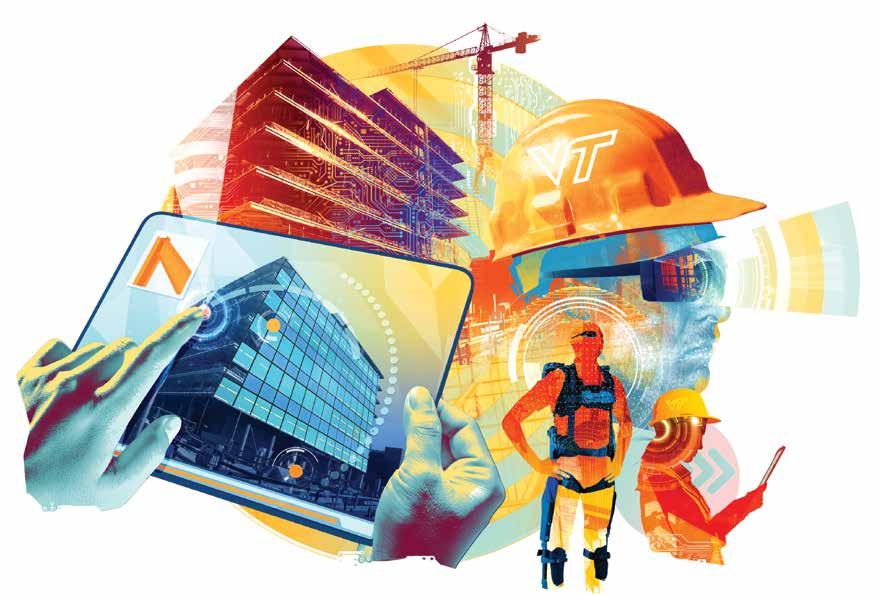
“One of the greatest concerns of a lot of the high-tech companies in construction is that they don’t have enough people trained to implement these sensors,” Akanmu said. “And it costs money to send workers to companies to be trained.” Bulbul, an associate professor, uses sensors to model, design, and monitor replicas of buildings in ways that allow developers to plan, maintain, and evolve structures to optimize efficiency. “Construction never ends,” Bulbul said. “There’s always construction on hospitals, in airports. For these kinds of structures and infrastructure projects, you need a model, or what we now call a digital twin. You start with design and keep adding information, and the physical building and digital twin eventually can interact. They can exchange information and be used to update each other.” Akanmu and Bulbul are bringing this necessary approach to their research and teaching, balancing a deep knowledge in their respective fields with collaborators who possess different backgrounds, expertise, and skills. Smart construction requires a team-based approach. The challenge facing companies is how to approach a changing industry that requires specialized knowledge not just in building, but in computer science, design, and other fields that vary by projects. Virginia Tech doesn’t teach to specific technology, but instead equips students with the skills to adjust, adapt to, and ultimately direct technological changes in an ever-changing world. “We’re not training workers for construction; we’re training managers and leaders of construction projects and construction processes,” said Brian Kleiner, the Bogle Professor of Engineering and director of the Myers-Lawson School of Construction. “What they manage will be some combination of technology and people. We try to instill that in them and at the same time expose them to the principles behind the trends driving the future, knowing that specific technologies may change. As a result, they graduate as leaders.” In some cases, leadership may involve deciding where automation is needed—but also where it is not. “We put people first—how technology and automation can support the human endeavor and not the other way around,” Kleiner said. “We need to be really careful that we’re serving people in societies. It’s a different philosophical approach compared to tech-based universities that are driving technological development for its own sake.” “We’re not training workers for construction; we’re training managers and leaders of construction projects and construction processes. What they manage will be some combination of technology and people. “
BRIAN KLEINER
THE BOGLE PROFESSOR OF ENGINEERING AND DIRECTOR OF THE MYERS-LAWSON SCHOOL OF CONSTRUCTION

“We’re finding more and better ways to engage with companies and move new discoveries made at Virginia Tech into the marketplace. That process extends their benefit to more people in the world and helps fulfill an imperative of our service ethic and mission as a land-grant university. BRANDY SALMON “ ASSOCIATE VICE PRESIDENT FOR INNOVATION AND PARTNERSHIPS
THE FUTURE OF HEALTH CARE

For an example of how Ut Prosim (That I May Serve) undergirds Virginia Tech’s approach to the future, consider how an array of colleges, institutes, and programs all are working to improve the design of medical facilities.
Industrial design faculty in the School of Architecture + Design are partnering with faculty in the Fralin Biomedical Research Institute and Virginia Tech Carilion School of Medicine on projects ranging from working with wounded veterans to address their unmet health care needs to partnering with the health care industry to redesign hospital treatment rooms in ways that offer more-efficient tools for doctors while improving the patient experience. Since the pandemic, that effort has increasingly grown to include telemedicine advances as well. The Institute for Creativity, Arts, and Technology (ICAT) partnered with Steelcase, a workspace design company, and built a team that included members from the Fralin Biomedical Research Institute, College of Architecture and Urban Studies,
and College of Engineering to reimagine the hospital workspaces. The team interviewed and observed real-life emergency procedures and workflows in multiple Carilion Clinic hospitals to get better information to clinicians and doctors when and where they need it. The ICAT team drew inspiration from unexpected places:
• Technology used by rideshare apps, which allows clinicians to see the arrival time of location of ambulances and EMTs.
• Way-finding Bluetooth technology that allows clinicians to see what’s happening throughout the unit, even when they’re not physically present.
• Cockpit-style monitors that show each patient’s vital signs and a camera feed from the hospital room, as well as specialized displays outside each room that allow clinicians to view important information from the hallway.
Because of Virginia Tech’s close partnership with Carilion Clinic, its researchers are grounded in the day-to-day reality of what works and what doesn’t in a real-world setting.
“We worked closely with Steelcase to look at what are the workflows and how can workflows change as we provide more technology to the environment,” said Tom Martin, ICAT’s deputy executive director and a professor of electrical and computer engineering. “We want to provide more situational awareness for the team—who’s in the room, who needs to be in the room. Particularly in emergency situations, rooms can get very crowded, and it’s hard to figure out who should be in the room and who shouldn’t.” The team’s work is a critical first step that will inform the design of products that will be used in hospitals but may also be applied to other areas of work. The university supports the flow of research and ideas into the public and private spheres through Virginia Tech’s LINK + LICENSE + LAUNCH, a one-stop shop for companies and entrepreneurs that builds partnerships; actively engages with the market; and makes connections for alumni, corporate partners, and federal and state partners. LINK supports strategic partnerships across the university, and now, efforts associated with the Innovation Campus. Last year, LICENSE supported 20 new intellectual property licenses, six tech startups, and 148 invention disclosures from the Tech community. It supported applications for more than 70 patents and three new varieties of plants, with more than 50 patents awarded. LAUNCH initiated a new Proof-of-Concept grant program to provide much needed funding to technologies with potential for real-world application. The team targets the kinds of high-demand fields where Virginia Tech thrives, such as autonomy, digital techology, cybersecurity, satellite technologies, transportation, biomedicine, devices and robotics, and agriculture. Not coincidentally, those fields show up in McKinsey’s future of work report as highgrowth sectors in coming decades. “We’re finding more and better ways to engage with compapanies and move new discoveries made at Virginia Tech into the marketplace,” said Associate Vice President for Innovation and Partnerships Brandy Salmon. “That process extends their benefit to more people in the world and helps fulfill an imperative of our service ethic and mission as a land-grant university.”

LIFELONG LEARNING IN AN EVER-CHANGING WORLD The graduates of today—especially those whose experience has been disrupted by the coronavirus pandemic—will become tomorrow’s leaders. That may sound cliche, but as Moore’s Law drives us toward even faster technological advancement, it’s a truth that’s foundational to Virginia Tech’s mission. The university’s model of experiential learning offers students a competitive advantage, combining disciplinary depth with opportunities to build leadership, teamwork, communication, critical thinking, problem-solving, and other key skills. The qualities required for career successes in the economy of today, much less tomorrow, are rapidly changing. That’s why Virginia Tech approaches education not just from an undergraduate or even graduate perspective, but with the understanding that its students and alumni will embrace a lifetime of learning as they adapt to new situations and environments. Lifelong learning is a fundamental part of the university’s mission and history. Its Cooperative Extension agents provide training for Virginians at locations throughout the commonwealth. Outreach and International Affairs (OIA) offers job retraining and workforce development through continuing and professional education, including Virginia Tech Bootcamps—live, online courses that address the tech industry’s increasing skills gap. Targeting early-career or experienced professionals, the new part-time, 26-week bootcamps teach skills that qualify participants for high-paying, in-demand coding and cybersecurity jobs in the greater Washington, D.C., metro area and beyond. “The growth of high-paying, in-demand jobs can be realized only if workers are able to receive the necessary education and skills,” said Shelly Jobst, director of OIA’s continuing and professional education. “Continuous learning is key to making that happen. Sharing this sort of professional education is fundamental to our land-grant mission to respond to the greatest needs across the commonwealth, including improving educational attainment and preparing a highly trained workforce.” A COMMITMENT TO INNOVATION Virginia Tech continues to innovate. In January 2019, the Calhoun Center for Higher Education Innovation at Virginia Tech launched a multiyear project designed to explore the connections between adaptation and inclusiveness in learning. The project dives into how the entire educational system, including K-12, can better prepare tomorrow’s learners to succeed throughout their working lives. The center recently released a report marked by a full-fledged commitment to adaptive learning. Published by Virginia Tech Publishing, the report is just one step in the process toward shifting traditional educational practices into new, more innovative and effective directions, those involved say. The group is already engaged in a next step for the project: recruiting teams to put the report’s recommendations into practice on as wide a scale as possible.
“We’re all trying to predict a future job market that is increasingly unpredictable,” said Daniel Kjellsson, managing director of the Future Talent Council, a global membership organization of talent leaders from the educational, corporate, and governmental sectors. “What we do understand, however, is that talent development will most likely happen throughout one’s professional life—and looking at that timeline right now we see gaps.”
Land-grant universities were developed to expand the number of higher education institutions preparing people with practical, technical skills as a response to the industrial revolution and changing social dynamics. While that mission has evolved, and broadened, it does mean that Virginia Tech has a special responsibility to adapt to society’s changing needs, Thanassis Rikakis, executive director of the Calhoun Center said.
“Land-grants of the 21st century should be tackling these hard questions head on,” said Rikakis. “That’s why we were created. Increasing participation in the economy has always been part of the mission of land-grants. However, the economy and society have changed, the participation needs to be broader and more diversified than ever, and the ways to increase participation need to be adapted.”
FORWARD THINKING For more information about lifelong learning and Virginia Tech's efforts to educate the leaders of the future, visit vtmag.vt.edu.
“We’ve created a global knowledge economy, but only a small percentage of the population is fully participating.
Land-grants of the 21st century should be tackling these hard questions head on. That’s why we were created. We weren’t created to just keep on doing what we did in the 19th century or the 20th century. “
THANASSIS RIKAKIS
EXECUTIVE DIRECTOR OF THE CALHOUN CENTER

Sylvester Johnson, Oct. 2019
THE INTERSECTION OF TECHNOLOGY AND HUMANITY

IN THIS MODERN AGE, TECHNOLOGY’S FUTURE MAY SEEM DARK AND APOCALYPTIC OR FANTASY-LIKE. TOMORROW SITS ON A PRECIPICE BETWEEN THE POTENTIAL POSSIBILITIES.
RATHER THAN WAITING TO SEE HOW THE FUTURE EVOLVES, VIRGINIA TECH IS PROMOTING A FUTURE IN WHICH EMERGING TECHNOLOGIES ARE IN SERVICE TO HUMANITY. THE UNIVERSITY IS TAKING HUMANCENTERED APPROACHES TO ADDRESS THE SOCIETAL IMPACT OF TECHNOLOGICAL INNOVATION.
“Virginia Tech is uniquely positioned to lead in this new era,” said Sylvester Johnson, assistant vice provost for the humanities. “Regionally, nationally, and globally, we are setting a new standard with Tech for Humanity, a university-wide initiative focused on the human-centered guidance of technology.” Under Johnson’s leadership, Tech for Humanity focuses on ensuring a thriving future for humanity that emphasizes ethics, empathy, policy, equity, creativity, inclusion, diversity, and sustainability. Through the Center for Humanities, which Johnson also directs, cross-disciplinary collaborations enhance the university’s efforts to create responsible technologists. “These are people who care, commit to, or are involved with advancing human interests through technology,” Johnson said. Tech for Humanity scholars and the Center for Humanities encourage research in arts, human-centered social sciences, humanities, and technological fields. The center also partners
with the university’s legislative liaisons and faculty members in the Department of Political Science and the Policy Strategic Growth Area to engage legislators in issues of public policy. It additionally educates corporate entities on matters of ethics and the impact of technology on humans. Combining technology and society is not a new idea for Virginia Tech. Joseph Pitt, a philosophy professor, was an early leader of Virginia Tech programs focused on how technologies affect humanity. “We started looking at science and its tools and saw its ramifications from sociological, philosophical, and political lenses,” said Pitt. “So, we developed a program where students could decide which aspects to pursue.” That effort eventually led to the development of the Department of Science, Technology, and Society. Rebecca Hester, an assistant professor in the department, is a Tech for Humanity scholar specializing in equity and social disparity in the human condition. Her research interests, which began with the study of immigration, now encompass the social, ethical, and political implications of scientific and technological advances in biotechnology, biomedicine, and public health. “When it comes to technology, I start with a conversation about social values,” Hester said. “We need to reflect on what it is we value and what we should make manifest in the world. That has to do with what it means to be human, who we are, what we value, and what we think we need. Then we can decide on the technology.” Hester cited her research on immigration: The immediate answer to problems that arise from immigration is not necessarily more surveillance technologies. Instead, the conversation should define the underlying cause, she said. “There has never been a greater need for people to be at the table who understand the social, political, cultural, and economic implications of the technologies that society is promoting,” said Hester. “We are shaping the next generation, who will use and create technologies—people who think not just ethically, but also politically and socially about the technologies and the science that they’re doing.” Such initiatives are central to Virginia Tech’s mission. “We teach people,” Johnson said, “and the structure of our coursework and curriculum needs to show that technology is more than a science and engineering concern. It’s a societal issue, a human issue. It encompasses the political, the economic, the cultural, the personal.” Johnson said the university prepares students to understand that technology has wide-ranging implications that involve everyone, not just scientists. “To be future stakeholders, students must be informed and analytically astute,” he said. “They must understand equality, social systems, power, and how the world works at an institutional level and what it means at a human level.” Through targeted programs, Virginia Tech is creating a new generation of responsible leaders who understand the importance of ensuring humanistic applications of technological advances. Working directly with undergraduates through the Calhoun Discovery Program, a transdisciplinary program run by the Center for Higher Education Innovation that focuses attention on technical innovation and societal transformation, Johnson is optimistic about the future of technology and humanity. “That program runs across 10 different majors, and we have corporate partners in private industry who contribute their time and capital,” Johnson said. Johnson added that a program that is diverse and includes underrepresented students is critical, because without gender, racial, ethnic, and income diversity, society will face recurring historical problems of inequity. “We need people with the perspectives, insight, and backgrounds to produce the outcomes that will benefit everyone in society,” he said. By investing in initiatives that focus on the human dimensions of innovation and by infusing technologies with insights from the humanities, Johnson said, Virginia Tech is showing its commitment to lead social institutions in addressing the big challenges that emerging technologies pose. “Virginia Tech is preparing leaders for tomorrow, for a future not yet imagined,” he said. “We shape leaders who know that technology must be judged ultimately not by its wow factor, but by whether it contributes to a society we want to live in, one that’s for the greater good of all humanity.”
Leslie King is the marketing and communications manager for the College of Liberal Arts and Human Sciences.









